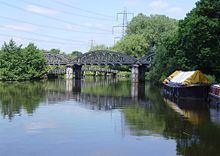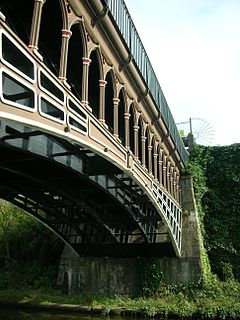Kennington Railway Bridge | |
|---|---|
 Kennington Railway Bridge from downstream. Beyond the bridge can be seen the crossing at the confluence of Hinksey Stream. | |
| Coordinates | 51°43′17″N1°14′32″W / 51.721345°N 1.242253°W Coordinates: 51°43′17″N1°14′32″W / 51.721345°N 1.242253°W |
| Carries | Former Wycombe Railway |
| Crosses | River Thames |
| Locale | Kennington, Oxfordshire |
| Maintained by | Network Rail |
| Characteristics | |
| Design | bowstring bridge |
| Material | steel |
| Height | 13 feet 6 inches (4.11 m) [1] |
| Longest span | 83 feet (25 m) |
| No. of spans | 3 |
| Rail characteristics | |
| No. of tracks | 1 |
| Track gauge | standard gauge |
| History | |
| Designer | AC Cookson, ACGI, MICE |
| Constructed by | George Palmer |
| Fabrication by | Horseley Bridge and Engineering Co Ltd |
| Opened | 1923 |
| Replaces | 5-span bridge built in 1863 |
Kennington Railway Bridge is a railway bridge over the River Thames near Kennington, Oxfordshire between Sandford Lock and Iffley Lock. It carries the freight railway branch line that serves the BMW Mini factory at Cowley. The freight railway is part of the former Wycombe Railway that linked Maidenhead and Oxford via High Wycombe and Princes Risborough.

The River Thames, known alternatively in parts as the Isis, is a river that flows through southern England including London. At 215 miles (346 km), it is the longest river entirely in England and the second-longest in the United Kingdom, after the River Severn.

Kennington is a village and civil parish in the Vale of White Horse district of Oxfordshire, just south of Oxford. The village occupies a narrow stretch of land between the River Thames and the A34 dual carriageway. It was in Berkshire until the 1974 boundary changes transferred it to Oxfordshire.

Sandford Lock is a lock on the River Thames in England, situated at Sandford-on-Thames which is just South of Oxford. The first pound lock was built in 1631 by the Oxford-Burcot Commission although this has since been rebuilt. The lock has the deepest fall of all locks on the Thames at 8ft 9in (2.69m) and is connected to a large island which is one of three at this point. The lock lies at the end of Church Lane in Sandford on Thames.
Contents
The current bridge was built for the Great Western Railway in 1923. It is a steel bowstring bridge of three equal spans, each 83 feet (25 m) long. The railway on the bridge is on a curve with a radius of 12 chains (240 m). The bridge crosses the river askew. [2]

The Great Western Railway (GWR) was a British railway company that linked London with the south-west and west of England, the West Midlands, and most of Wales. It was founded in 1833, received its enabling Act of Parliament on 31 August 1835 and ran its first trains in 1838. It was engineered by Isambard Kingdom Brunel, who chose a broad gauge of 7 ft —later slightly widened to 7 ft 1⁄4 in —but, from 1854, a series of amalgamations saw it also operate 4 ft 8 1⁄2 in standard-gauge trains; the last broad-gauge services were operated in 1892. The GWR was the only company to keep its identity through the Railways Act 1921, which amalgamated it with the remaining independent railways within its territory, and it was finally merged at the end of 1947 when it was nationalised and became the Western Region of British Railways.

A tied-arch bridge is an arch bridge in which the outward-directed horizontal forces of the arch(es) are borne as tension by a chord tying the arch ends, rather than by the ground or the bridge foundations. This strengthened chord may be the deck structure itself or consist of separate, deck-independent tie-rods.
The chain is a unit of length equal to 66 feet. It is subdivided into 100 links or 4 rods. There are 10 chains in a furlong, and 80 chains in one statute mile. In metric terms, it is 20.1168 m long. By extension, chainage is the distance along a curved or straight survey line from a fixed commencing point, as given by an odometer.


















